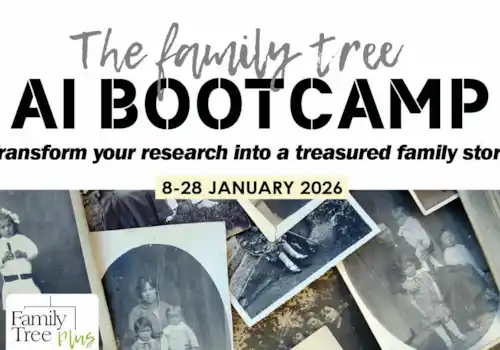Learn how to use FamilySearch, the world's largest family history website, for tracing ancestors, using its billions of records to build your family tree for free.
Trace your family tree for free with FamilySearch
With records in terms of millions (over 6 billion in fact) and historical details from numerous nations from around the world, FamilySearch is the world’s largest family history website - and what’s more it’s packed with free resources. Read on to discover how to use them to research your ancestors, grow your family tree online, connect with distant relations, and record your family’s story and memories for posterity.
Go to the Family Search website, select ‘Search’, and enter a name of an ancestor or two. You’ll soon realise that it’s worth creating a FamilySearch account, as this will let you attach the records you find to your own - growing - online family tree.
How use the FamilySearch website for tracing ancestors
- Select 'Tree' to view your family tree layout with brief details for each person. 'Person' shows editable fields for that individual. 'Find' allows you to search for records. Use the 'Lists' feature to watch for connections of specific people you’re ‘watching’
- Search the records on FamilySearch and attach records you find directly to your FamilySearch family tree
- Select the relevant ancestor from your tree to attach the record to them
- Select a person's name to zoom in to view the details on their 'index card'
- Select their name or 'person' on the index card to be taken to the editable fields. Here you can add and amend details for that ancestor
Why use FamilySearch?
- It’s free to set up and use your account.
- If you find search results that fit in with your family tree, simply click ‘attach to tree’. Not only does this make for quick research, it also helps to ensure you can retrace where you found the details (which record they came from).
- You will notice that when you add details to your family tree, FamilySearch automatically includes a field for you to state how you know this information. Get into the habit, right from the start of including source information. (It’s not too late to go back and fill in these details at a later date, so don’t procrastinate - you’ll be pleased you bothered).
- You have to select ‘living’ or ‘deceased’ for each person that you add to your tree - so that the privacy of living individuals is protected.
- When you add someone to your family tree, FamilySearch will automatically search the vast collection of other people’s trees recorded on Family Tree, to identify possible matches. You can opt to ‘match’ or ‘add new’ if you aren’t sure that the match is certain.
- You can add numerous siblings and children. This is useful as it can help to connect you with a greater number of possible matches. And it is also a fun way of engaging the rest of your family in family history, so that they can see where they are on the family tree.
Tip: When searching for ancestors within the FamilySearch interface, note also that you can also opt to search the data collections held on Ancestry, Findmypast and MyHeritage.
Sharing family records
However, growing your family tree online is just part of the project. Via the ‘Memories’ section of the FamilySearch website you can add written memories or audio records, and create galleries and albums of family photos.
- Select the 'Memories' tab to see where you can add audio recordings of memories or written accounts, or create albums and galleries
How to search the FamilySearch website
There are two main ways to search: via the ‘Records’ (the indexes, transcripts and images) or the ‘Genealogies’ (pedigrees researched by other family historians).
The Genealogies have come from a variety of sources and include hundreds of millions of names. Be sure to note the accuracy of any data that seems to match, as it is not all verified by sources. The Records are the main route you are likely to take for researching ancestors’ details.
- From the 'Records' fill in the search fields with the details of an ancestor you're looking for
- Scroll down the search page to find a collection and research by area. And be sure not to miss the link to ‘browse all published collections’. If you’re unfamiliar with FamilySearch this is the best place to explore the many types of records that FamilySearch can provide access to.
- Selecting 'United Kingdom and Ireland' reveals a list of more than 120 collections, for instance, and to see the latest additions simply click 'Last updated'
Research tip
To better understand the record collection that you’ve chosen to search, click ‘Learn more’. This will provide you with further information about the collection - the date span or area it covers, whether there’s still work to come on the collection etc.
Details such as this can help to explain why you might not find someone you’re looking for, but also show you that it could be worth returning to search the collection again at a later date.
And lastly - on FamilySearch there’s always something new to learn...
Use the ‘Catalog’, ‘Books’ and ‘Wiki’ sections to expand your research. And why not think about volunteering to help with indexing some of the records. Not only will you be helping fellow family historians to research their ancestors, you’ll gain in depth knowledge of record collections, and see your palaeography skills improve no end.

















